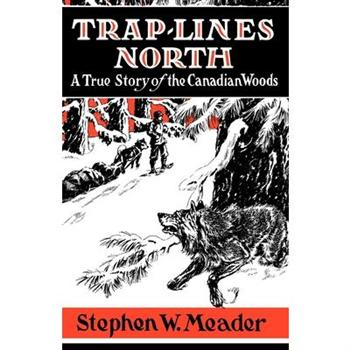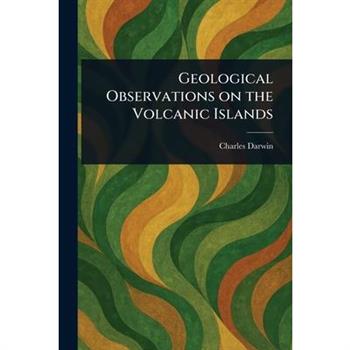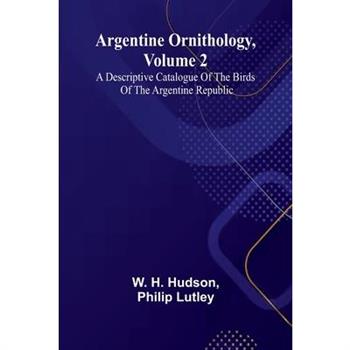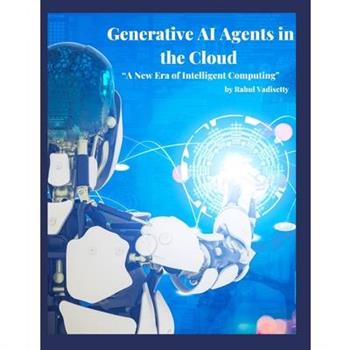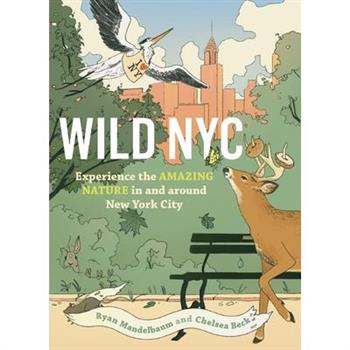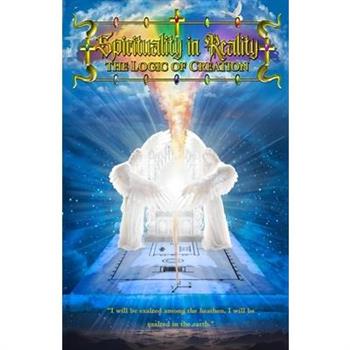Argentine Ornithology, Volume 2; A Descriptive Catalogue Of The Birds Of The Argentine Republic.
Discover the enchanting world of Argentine Ornithology, Volume 2, a timeless masterpiece that has soared back into print after decades of obscurity. This beautifully restored edition by Alpha Editions is not just a reprint; it s a collector s item and a cultural treasure, meticulously preserved for today s and future generations. Dive into the vibrant landscapes of the Argentine Republic through the eyes of W. H. Hudson and Philip Lutley, as they paint a vivid tapestry of the region s avian wonders. This descriptive catalogue is a unique blend of scientific precision and poetic elegance, capturing the essence of each bird species with unparalleled detail and passion. Whether you re a casual reader, a nature enthusiast, or a collector of classic literature, this book offers an irresistible journey into the heart of South America s rich biodiversity. Let the pages transport you to a world where nature s beauty and mystery unfold with every turn. Embrace this rare opportunity to own a piece of literary history, lovingly restored for those who cherish the art of storytelling and the wonders of the natural world.
Wild Cities
'Mind-shifting, heart-lifting' ISABELLA TREE 'Inspiring and essential' ALASTAIR HUMPHREYS Nature isn't a luxury, it's a necessity. But today the majority of the world's population lives in some form of urban environment. And by 2050, two-thirds of humanity will live in towns and cities. Studies have shown that a daily walk in the woods can improve our health and happiness, that those who can observe a natural scene through a hospital window will recover faster. The sound of birds, the smell of tree oils, the presence of free-flowing water - these are all vital to our wellbeing. So as the human footprint of brick, concrete and metal expands, how do we protect our connection to the natural world?In Wild Cities, Chris Fitch leads us around the world in search of answers, visiting pioneering cities and meeting the people working at the forefront of this issue. From the tiny urban forests in Tokyo and the star-rich skies of Flagstaff, to the meandering river of Munich and lions prowling through gardens in Nairobi, this is a globe-spanning look at how to bring nature into the places we live - and how to create the wild cities of the future.
The Mystery in the Rye
There are countless reports on microorganisms and their special abilities. The saga of the ergot fungus is perhaps the most unusual of them all. The unique history of this plant pathogenic microbe, which began with its infection of grasses, is told through a broad storyline that stretches from the early medical writings of Mesopotamia, Greece, and China, to the industrial and academic laboratories of pharmaceutical research in the 21st century.... Among cultivated grasses, the ergot fungus mainly infests rye. Its overwintering structure, the black-purple ergot kernel, grows out of the ears of the grain. The highly active substances it contains caused mass poisonings in Europe over a period of 1,000 years, in the course of which the victims suffered from terrible symptoms of illness. Only in the 17th century, doctors recognized ergot as the corpus delicti for the regularly recurring waves of mass poisoning. The development of drugs from pure ergot compounds is one of the fascinating contributions of pharmaceutical natural product and medicinal chemistry and was of great importance for the modernization of medicine. A straight line can be drawn from this research to the synthesis of LSD, whose accidentally observed psychotropic effect revealed the chemical basis of the psyche. In combination with other centrally active substances, the LSD studies opened the therapeutic research field of psychopharmacology. The ergot fungus stands for legendary advances in pharmaceutical science and human therapy. At the same time, the people who investigated this unique microorganism scientifically, for a wide variety of reasons, became part of its cultural history. Throughout the centuries, they have kept the wheels turning - an innovative power which is still effective today.
Wild NYC
A vibrant, family friendly guide to the unexpected nature found in and around the Big Apple. New York City may have a reputation as a concrete jungle, but in reality, it's full of amazing wildlife. You just need to know where to find it! Equal parts natural history, field guide, and trip planner, Wild NYC has something for everyone. It looks at the factors that shape local nature--including fire, floods, and climate--and profiles over 100 local species, from easy-to-spot squirrels and praying mantids to more elusive humpback whales, purple finches, and so much more. Also included are descriptions of day trips that help you explore natural wonders on hiking trails, in public parks, and on your own street.
Out Doing Science
Over the past 50 years, lesbian, gay, bisexual, transgender, and queer professionals have organized to achieve greater inclusion into the fields of science, technology, engineering, and mathematics (STEM). This inclusion, however, has come at a cost. In the 1970s, these professionals sought to radically transform STEM fields by confronting the homophobia and sexism embedded within them. Instead, these fields became more corporatized and privatized, and STEM institutions and workspaces--particularly in the spheres of government and business--became dominated by a focus on individualism, self-improvement/advancement, and meritocracy, which are hallmarks of neoliberalism. For many LGBTQ STEM professionals, inclusion now required becoming more apolitical, pro-capital, and focused on professional development. In Out Doing Science, Tom Waidzunas, Ethan Czuy Levine, and Brandon Fairchild explore this transformation of LGBTQ STEM professionals from oppositional outsiders to assimilationist insiders. Drawing on historical archives, oral interviews, and participant observation of professional societies and workspaces, the authors interrogate the meanings of "inclusion" and why some LGBTQ STEM professionals have benefited from it more than others. They also advocate for a "queer STEM" that challenges and transforms the racism, classism, sexism, cisheterosexism, and imperialism of these fields, institutions, and workspaces. Written in an accessible and engaging style, Out Doing Science will appeal to readers interested in LGBTQ studies, and science and technology studies, as well as anyone who wants to create a more diverse and inclusive work environment.
A Land Before Humans, a Land After Humans
'Some species survive reliant on conservation, some may survive eluding our knowing, some may not survive despite our efforts, and some may survive by adapting to and integrating with human worlds' . New Zealand is a unique and fascinating country as a case study for managing invasive species. Because of its history we know a lot about species introductions, and because of its geographical position, as a relatively small remote island, the potential for dealing with invasive species may be more effective than elsewhere. Moreover, the fragility of its ecosystems makes it relatively easy to see the impact of one species upon another. Nature and people shape the country's ecology: from its geological and biological beginnings to the relatively recent arrival of people and the changes wrought, to the wide-ranging efforts of individuals and communities to protect and enhance treasured species and environments. Among them, an ambitious Predator Free 2050 initiative to rid the country of some of its unwanted species. The issue is a complex and interesting one. There are ethical considerations - which species are protected, and which destroyed? How are they destroyed? What are the unforeseen consequences? There are also tensions between preservation and the use of natural resources, and ultimately our relationship to the environment, how we live. A Land Before Humans, a Land After Humans explores these issues. An invaluable resource for environment, ecology, animal welfare and ethics students, researchers and policy makers, the book takes New Zealand as a case study and looks at the practical and ethical considerations of dealing with invasive species.
The New Order
What if the great discoveries of science came in the "wrong" order? The Laws of Thermodynamics were discovered well after the creation of algebra, classical physics, and chemistry, but are perhaps much more important to our basic understanding of the universe. This flawed chronology led to a confusion that has prevented a cross-curricular understanding of the sciences. With the development of Artificial Intelligence, it will soon be possible to solve the philosophical and biological problem of solipsism, the problem that all of our scientific discoveries have been necessarily - and incorrectly - built upon anachronistic foundations. In other words, we've built our fundamental understanding of science out of order. In The New Order: How AI Rewrites the Narrative of Science, Chris Edwards shows that AI will be able to understand science outside of the traditional l chronological developments of the sciences, unlocking entirely new potentials and perspectives on the universe. If human scholars are to understand how AI interprets the universe, we will first need to understand the scientific narrative in a "new order." Moving through the dawn scientific history to modern quantum physics, Edwards frames a "new order" to place thermodynamics in its proper place at the center of our scientific universe. AI is likely to view the history of the universe through entropy and probability, and with the insights and invention of The New Order, readers can, too.
Studies on the Confocal Laser Microscope
This book provides a thorough exploration of various modulated apertures and their impact on improving microscope resolution, with a focus on confocal scanning laser microscopy (CSLM). Over the course of eleven chapters, it looks at both the theoretical aspects and practical applications of different aperture shapes. Chapters 1 and 2 review apertures with linear, quadratic, and concentric black-and-white (B/W) zones, along with linear-quadratic and polynomial designs. Additionally, apertures with Hamming, Cauchy, rectangular, and hexagonal shapes are analyzed for their potential to enhance imaging performance. Chapter 3 presents the computation of coherent transfer functions (CTFs) for selected modulated apertures, offering insights into their influence on imaging quality. Chapter 4 focuses on confocal microscopes, exploring how these apertures affect the imaging of microscopic objects. A theoretical study of coherent non-scanned laser microscopes (CNSM) is covered in Chapter 5. Chapter 6 addresses the computation of lateral and axial point spread functions (PSFs) in confocal imaging systems that use binary amplitude masks, while Chapter 7 investigates the effects of misalignment errors combined with wavefront aberrations in systems using linear and quadratic apertures. In Chapter 8, diffraction intensity is calculated for a confocal microscope with a laterally displaced truncated Gaussian aperture, extending the principles of Marechal microscopy to confocal scanning microscopy. Chapters 9 and 10 examine spatial coherence in confocal optical systems, particularly in the context of quadratic and concentric B/W apertures. The book concludes in Chapter 11 with an application of cardiac apertures in CSLM, demonstrating their use in processing cardiac images. This work serves as a valuable reference for researchers and professionals interested in advancing microscope resolution through innovative aperture design and analysis.
Writing Science in Plain English, Second Edition
An updated edition of the essential guide for all scientists--from undergraduates to senior scholars--who want to produce prose that anyone can understand. Scientific writing is often dry, wordy, and difficult to understand. But, as biologist and experienced teacher of scientific writing Anne E. Greene shows in Writing Science in Plain English, writers from all scientific disciplines can learn to produce clear, concise prose by mastering just a few simple principles. This short, focused guide presents roughly a dozen such principles based on what readers need to understand complex information, including concrete subjects, strong verbs, consistent terms, organized paragraphs, and correct sentence structure. Greene illustrates each principle with real-life examples of both good and bad writing and shows how bad writing might be improved. She ends each chapter with revision exercises (and provides suggested answers in a separate key) so that readers can come away with new writing skills after just one sitting. To help readers understand the grammatical terms used in the book, an appendix offers a refresher course on basic grammar. For this second edition, Greene has incorporated the latest research on what makes writing effective and engaging and has revised or replaced exercises and exercise keys where needed. She has also added new features that make it easier to navigate the book. A new resource for instructors who use Writing Science in Plain English in their classes is a free, online teacher's guide. Drawn from Greene's long experience teaching students how to write science clearly, the teacher's guide provides additional lectures, assignments, and activities that will inform and enliven any class.
The Nsta Quick-Reference Guide to the Ngss, High School
Since the release of the first draft of the Next Generation Science Standards (NGSS), NSTA has been at the forefront in promoting the standards and helping science educators become familiar with and learn to navigate this exciting but complex document. Later, when the final version was released and states began adopting the standards, NSTA started to develop resources that would assist educators with their implementation. Along the way, NSTA learned that even the simplest of resources, like a one-page cheat sheet, can be extremely useful. Many of those tools are collected here, including - a two-page "cheat sheet" that describes the practices, core ideas, and crosscutting concepts that make up the three dimensions described in A Framework for K-12 Science Education; - an "Inside the Box" graphic that spells out all of the individual sections of text that appear on a page of the NGSS; - a Venn diagram comparing the practices in NGSS, Common Core State Standards, Mathematics, and Common Core State Standards, English Language Arts; and - matrices showing how the NGSS are organized by topic and disciplinary core idea. This guide also provides the appropriate performance expectations; disciplinary core ideas; practices; crosscutting concepts; connections to engineering, technology, and applications of science; and connections to nature of science. It is designed to be used with the NGSS. The NSTA Quick-Reference Guides to the NGSS are also available in grade-specific versions--one each for elementary and middle school--plus a comprehensive K-12 edition. The four Quick-Reference Guides are indispensable to science teachers at all levels, as well as to administrators, curriculum developers, and teacher educators.
What We Value
With so many competing priorities pulling us in different directions every day--family, friends, work, our health--it can feel difficult to make decisions that are aligned with what we care about most. Especially in the moment, we often default to the immediate demand, the path of least resistance, the worn old habit we wanted to change. In What We Value, pioneering scholar Emily Falk reveals how we can transform our relationship with the daily decisions that define our lives--opening pathways to make more purposeful, fulfilling choices; more successfully change our behavior; and influence others to see differently--by thinking like neuroscientists.Drawing on her own award-winning research, Falk introduces readers to a new paradigm for understanding why we, and those around us, do what we do. This is the value calculation: the often-subconscious mechanism by which the brain computes our everyday choices. By learning how it works, Falk shows, we can learn to work more strategically with it--whether we want to embrace new activities and behaviors, connect more meaningfully with others, or become more effective leaders in our organizations and communities. With captivating stories of star comedians, journalists, sports legends, and more, Falk demonstrates how we can change what we think just by changing what we think about; get less defensive by connecting with our core values; and seed innovation by seeking out different perspectives.Whether deciding on something as small as what to eat for lunch or as big as what career to pursue, we can have more agency and flexibility than we might think. What We Value is a groundbreaking guide to finding new possibilities in our choices--and the lives we ultimately make with them.
The Exhausted Brain
Revitalize Your Brain, Reclaim Your Mental Energy Everyone knows the feeling after a long day--it is difficult to concentrate, make good decisions, or even empathize with others. This daily but completely natural decline in our mental capacity is called "ego depletion," a state of mind that miraculously but naturally disappears after a good night's sleep. However, more and more people are waking up in a perpetual state of ego depletion: their mental energy source is not recharging--it is actually shrinking. We live in a chronically exhausted society with disastrous consequences for ourselves, society, and future generations. In The Exhausted Brain, Dr. Michael Nehls uncovers the source of our mental energy. He reveals where our "brain battery" is located, what function it serves within our brain, and how we can stop and reverse the decline in its capacity--with profound consequences for our mental wellbeing and social capacity. In short, this book will change the world.
The Nature of the Place
A love letter to the Adirondacks, revealing the hidden wonders and interconnected lives of its wildlife by one of the region's most prolific and prominent residents.The Nature of the Place is storied Adirondack nature writer Edward Kanze's invitation to slow down, smell the roses, and get to know fellow creatures with more longstanding claims to this landscape than we have. Theirs is the real internet, a web of life that weaves together an almost infinite number of threads into a fabric that's a wonder to behold and something close to a miracle in a largely hostile universe.In these dazzling pages, readers meet the big charismatic animals of the Adirondacks, the black bear and the moose. We encounter little creatures, too, all of which lead fascinating lives while nearly unseen: tiny fish that live in exquisite mountain streams; the infuriating and almost invisible biting insects called no-see-ums; centipedes; millipedes; and earthworms. Discover an orchid that pays a steep price for its rough treatment of bumblebees; plants so desperate for nitrogen they've taken to catching animals and eating them; poison-ivy and the reasons why we might want to exchange our dislike of it for love; and a common wildflower that goes through serial sex changes. Loons, owls, falcons, eagles, and songbirds pour out effusions of apparent ecstasy here, along with much about bobcats, foxes, snowshoe hares, beavers, and flying squirrels. Snakes, frogs, salamanders, and big predatory fish make appearances also, as well as fungi that produce light in the dark, and bacteria that manipulate the atmosphere to their own advantage, even causing rain and snow to fall.The Nature of the Place is Kanze's love letter to his home, the Adirondacks. Gathering materials from his decades-long column at the Adirondack Explorer and elsewhere, extensively revised and rewritten for this book, Kanze's singular meditations on the flora and fauna of his home resonate far beyond his own beautiful, beloved, biologically vibrant neck of the woods.
Recruiting Black Biology Majors into STEM Education Careers
Eavesdropping on Animals
"This book is fabulous and takes you close inside the wild world, where you feel the creatures whispering your old name."--Craig Foster, My Octopus Teacher Learn how to decode the secret conversations of wild animals all around you. From a Yellowstone naturalist and expert in animal language comes "a tantalizing guide to revamping our approach to wild things." (WSJ) Growing up in rural New York, as a young man George Bumann learned to track deer and turkeys as a hunter. Then everything changed. He left his hunting days behind and began an extraordinary journey into the more-than-human world ... Humans once relied on the calls of wild animals to understand the natural world and their place within it. Now, this remarkable guide reveals what our ancestors knew long ago--that tuning in to the owl in the tree, the deer in the gully, can tell us important information and help us feel connected to our wild community. In Eavesdropping on Animals, George Bumann shares the fascinating stories and insights he has gained from studying wildlife around the world for more than forty years, the last twenty of which have been spent leading popular programs on animal language and intelligence in Yellowstone National Park. Bumann shares tips, tricks, and advice for readers living in urban, suburban and rural areas and clearly shows us that you don't need an exotic vacation or a biology degree to have transformative wildlife encounters. Listening to and observing creatures in your own backyard, on nearby trails, and in local parks, seashores, fields, and forests can lead to extraordinary experiences and a profound sense of belonging. Are you ready to eavesdrop on your wild neighbors? Are you ready to learn how to tell a warning call from a mating call, a purr of satisfaction from idle chatter? Then this book is for you!
The Blind Spot
A compelling argument for including the human perspective within science, and for how human experience makes science possible. "This is by far the best book I've read this year."--Michael Pollan, Professor of the Practice of Non-fiction, Harvard University; #1 New York Times bestselling author It's tempting to think that science gives us a God's-eye view of reality. But we neglect the place of human experience at our peril. In The Blind Spot, astrophysicist Adam Frank, theoretical physicist Marcelo Gleiser, and philosopher Evan Thompson call for a revolutionary scientific worldview, where science includes--rather than ignores or tries not to see--humanity's lived experience as an inescapable part of our search for objective truth. The authors present science not as discovering an absolute reality but rather as a highly refined, constantly evolving form of human experience. They urge practitioners to reframe how science works for the sake of our future in the face of the planetary climate crisis and increasing science denialism. Since the dawn of the Enlightenment, humanity has looked to science to tell us who we are, where we come from, and where we're going, but we've gotten stuck thinking we can know the universe from outside our position in it. When we try to understand reality only through external physical things imagined from this outside position, we lose sight of the necessity of experience. This is the Blind Spot, which the authors show lies behind our scientific conundrums about time and the origin of the universe, quantum physics, life, AI and the mind, consciousness, and Earth as a planetary system. The authors propose an alternative vision: scientific knowledge is a self-correcting narrative made from the world and our experience of it evolving together. To finally "see" the Blind Spot is to awaken from a delusion of absolute knowledge and to see how reality and experience intertwine. The Blind Spot goes where no science book goes, urging us to create a new scientific culture that views ourselves both as an expression of nature and as a source of nature's self-understanding, so that humanity can flourish in the new millennium.
The Explorer's Gene
New York Times-bestselling author of Endure Alex Hutchinson returns with a fresh, provocative investigation into how exploration, uncertainty, and risk shape our behavior and help us find meaning. Off the beaten path, following unmarked trails, we are wired to explore. More than just a need to get outside, the search for the unknown is a primal urge that has shaped the history of our species and continues to mold our behavior in ways we are only beginning to understand. In fact, the latest neuroscience suggests that exploration in any form--whether it's trying a new restaurant, changing careers, or deciding to run a marathon--is an essential ingredient of human life. Exploration, it turns out, isn't merely a hobby--it's our story.In this much-anticipated follow-up to his New York Times bestseller Endure, Alex Hutchinson refutes the myth that, in our fully mapped digital world, the age of exploration is dead. Instead, the itch to discover new things persists in all of us, expressed not just on the slopes of Everest but in the ways we work, play, and live. From paddling the lost rivers of the northern Canadian wilderness to the ocean-spanning voyages of the Polynesians to the search for next-generation quantum computers, The Explorer's Gene combines riveting stories of exploration with cutting-edge insights from behavioral psychology and neuroscience, making a powerful case that our lives are better--more productive, more meaningful, and more fun--when we break our habits and chart a new path.
Waiwai
For over a century, business interests and political insiders controlled waters across the Hawaiian Islands to benefit a privileged few at the expense of stream ecology, taro farmers, and our islands' future sustainability. With the future of Hawai'i's precious water resources at a critical stage, this book is a groundbreaking exploration of water in Hawaiʻi that bridges ancestral place-based knowledge with present challenges faced by community members, cultural activists, academics, scientists, and policymakers alike. In Waiwai: Water and the Future of Hawai'i, Kamanamaikalani Beamer brings together experts from diverse fields to tackle complex issues in water management. Indigenous scholars recount how ancestral abundance revolved around the movement and health of water and articulate how these guiding principles transitioned to exploitation by plantation industrialists after the overthrow of the Hawaiian Kingdom. Legal scholars unpack the web of regulations governing water rights; scientists assess the damage already done to aquifers and ecosystems and suggest ways to improve them. The book also investigates environmental responsibility in the case of the fuel leak from the US Navy's Red Hill Bulk Fuel Storage Facility, giving county officials and community advocates a chance to uplift the concerns of those most impacted by the devastating tragedy. While providing readers with critical knowledge of the current status of water, the book's ultimate goal is to catalyze action. Chapter contributors aim to answer the central question: "What do people need to know about the future of water in Hawaiʻi, and what can they do to enable a better future?" The result is a bold vision for how everyone can work together for the long-term health of these islands we call home. Both accessible and critical, Waiwai sounds an alarm about the precarious state of water in Hawaiʻi. It is an interdisciplinary collaboration that illuminates past mistakes, makes clear present challenges, and equips readers with the knowledge and tools to come together and chart a way forward. With this book as a guide, community members, academics, scientists, policymakers, and aspiring visionaries are invited to redirect the course of water management toward sustainability, ensuring a legacy of abundance for future generations.
The Flora and Fauna of Monaghan
A highly visual and detailed history of the flora and fauna of County Monaghan, lovingly put together by the highly regarded botanist Alexis Fitzgerald.
Feminism in the Wild
How dominant culture--from sexism and homophobia to racism, capitalism, ableism, and more--has limited the science of animal behavior, and how we can free ourselves from these limited perspectives. In Feminism in the Wild, Ambika Kamath and Melina Packer reveal how scientists studying animal behavior have long projected human norms and values onto animals while seeking to understand them. When scientific studies conclude that these norms and values are natural in animals, it makes it easier to think of them as natural in humans too. And because scientists, historically and to this day, largely belong to elite, powerful segments of society, the norms and values embedded in animal behavior science match those of the already powerful. How can animal behavior science escape this trap of naturalizing dominant culture? Drawing from decades of feminist, antiracist, queer, disability justice, and Marxist contributions--including those of biologists--Kamath and Packer break down persistent assumptions in the status quo of animal behavior science and offer a multitude of alternative approaches. Core concepts in animal behavior science and evolutionary biology--from sex categories and sexual selection to fitness, adaptation, biological determinism, and more--are carefully contextualized and critically reexamined. This unique collaboration between an animal behavior scientist and a feminist science studies scholar is an illuminating and hopeful read for anyone who is curious about how animals behave, and anyone who wants to break free from scientific approaches that perpetuate systems of oppression.
Threat Versus Safety Theory (Tvst)
Threat versus Safety Theory is offered as an illuminated raw specimen on a microscope platform for the benefit of anyone who wishes to see something differently from a previous reality. TVST is a look at how life is ever changing along the spectrum of threat through safety. TVST starts with the oldest and simplest life forms and ends with the most complex and newest life forms-- humans--to explain chronic disease disability, pain, and suffering. TVST postulates that where we are on the threat versus safety spectrum determines whether we exist in disease and despair or in health and happiness.TVST explains how the interface of the environment with our genetic code determines our health, feelings, behaviors, relationships, thoughts, narratives, beliefs, and connections. Our internal and external environment plays our genetic code much like someone plays the keys on a piano--disconcerting noise and appealing music are both possible.TVST uses biology and physiology to explain the modern human condition and why we are failing as a species to fulfill our primary purpose-to protect and propagate our genetic code. We are destroying our planet, our home, and we are failing our progeny, our children. There will be a tipping point from which the species will not return...unless we correct course. With realistic pragmatism, TVST offers a new paradigm and considerations for a new treatment algorithm to restore the human species. Finally, TVST is an invitation to participate and collaborate in the evolution of the paradigm and in the application of the algorithm for the improvement of the human condition--a must-read for all of humankind.
The Ideological Brain
Named a best book of the year by The Guardian and The Telegraph Why do some people become radicalized? How do ideologies shape the human brain? And how can we unchain our minds from toxic dogmas? In The Ideological Brain, Leor Zmigrod reveals the deep connection between political beliefs and the biology of the brain. Drawing on her own pioneering research, she uncovers the complex interplay between biology and environment that predisposes some individuals to rigid ways of thinking, and explains how ideologies take hold of our brains, fundamentally changing the way we think, act and interact with others. She shows how ideologues of all types struggle to change their thought patterns when faced with new information, culminating in the radical message that our politics are not superficial but are woven into the fabric of our minds. This authoritative, accessible and playful blend of psychology, politics and philosophy explores the cutting-edge of the emerging field of political neuroscience. Zmigrod examines its historical roots before she looks to the future, considering the broader social and political implications of her groundbreaking research. Guiding readers through her experiments, she eventually describes what a free, authentic, and tolerant brain looks like, and explains how anyone can keep their mind open and flexible in the face of extremist ideologies.
Communication Does God Have a Problem? and Does It Matter?
There are many different understandings of God. This is evidenced by the multiplicity of faith groups and the variety within them. Has this situation come about because God has a communication problem ? Many of these groups claim that their own particular view is the only True and authentic understanding and thus everyone else is wrong. They behave and speak accordingly. This has, and still does, cause a range of harms. From personal guilt and shame to physical harm, torture and war. By demonstrating the evolutionary nature of knowledge, using science, philosophy and cosmology as exemplars, I suggest that similar processes also apply to understandings of God, faith and the scriptures. Using Evolution as a paradigm for change suggests that the different understandings of God are an inevitable consequence of the way God has set things up, not because of a breakdown in communication. Thus, we should embrace difference. Acceptance of this analysis leads to a radically different attitude. It means that no one faith can claim a monopoly on "The Truth" and we should accept the legitimacy of other understandings whilst acting and worshiping together as though there are none. Such a change in attitude is needed for everyones' sake and the future of the world.









